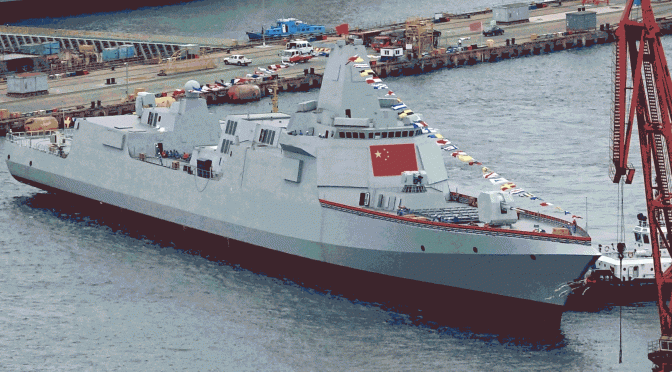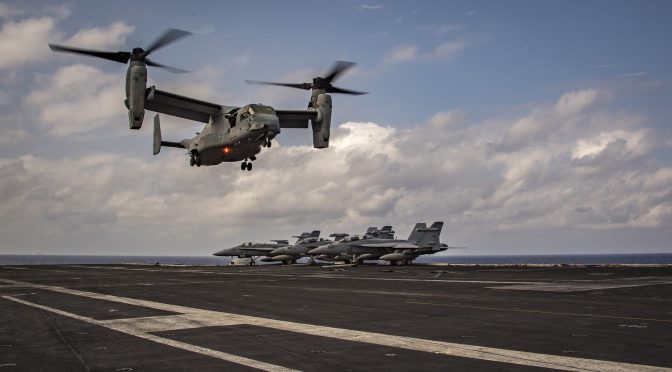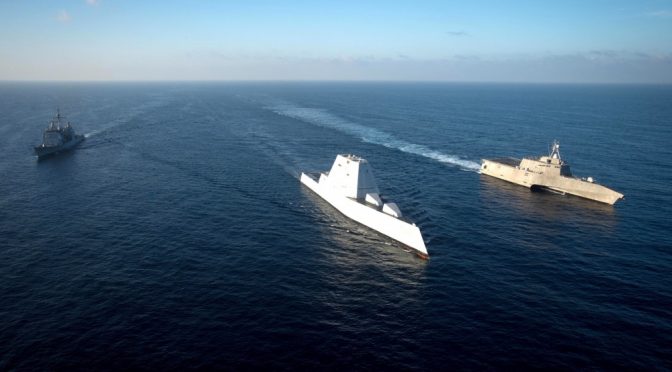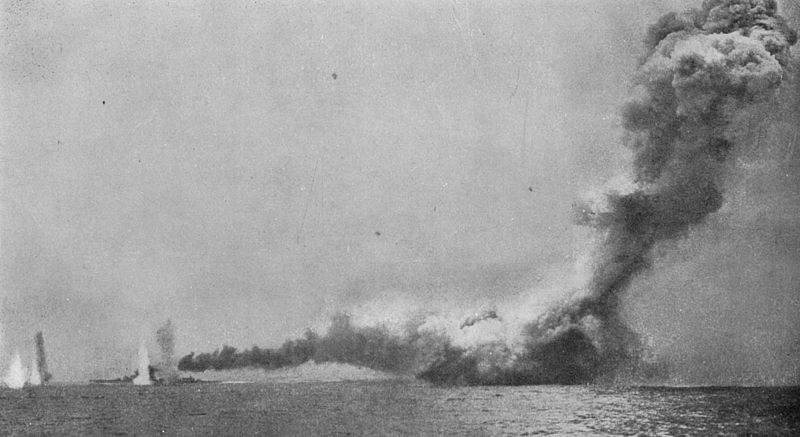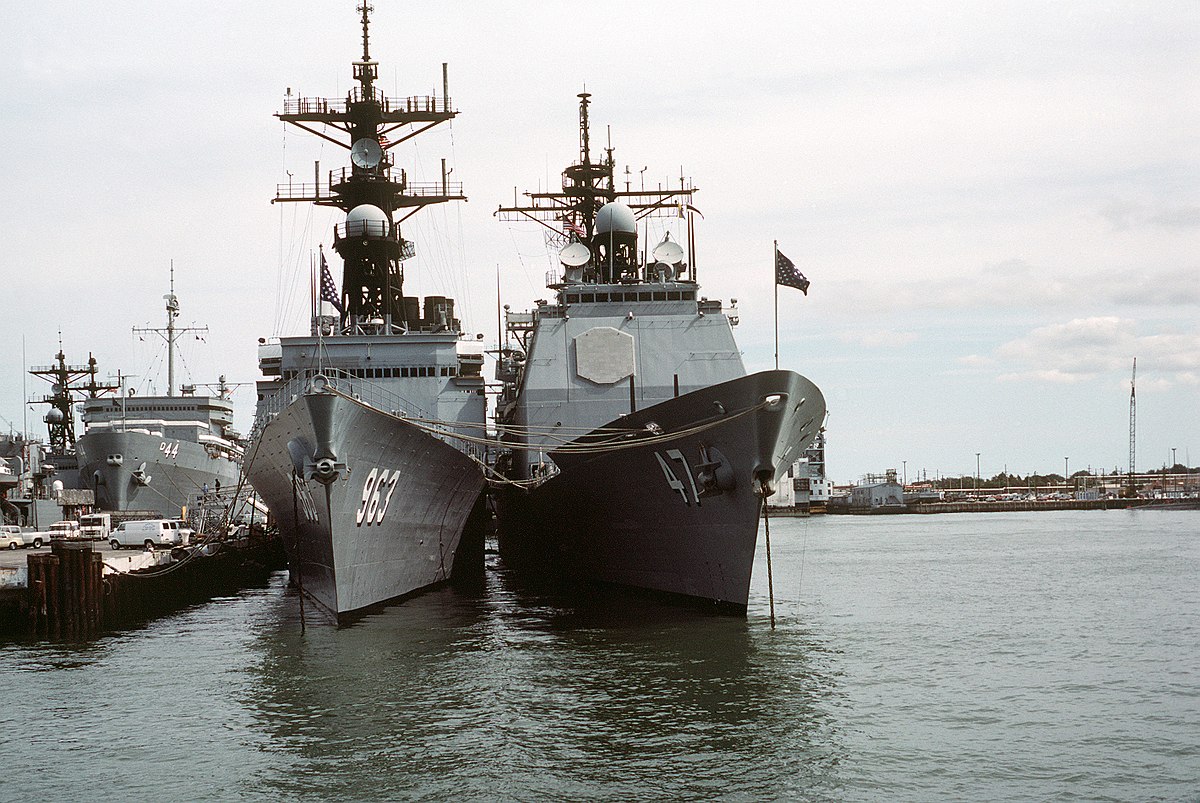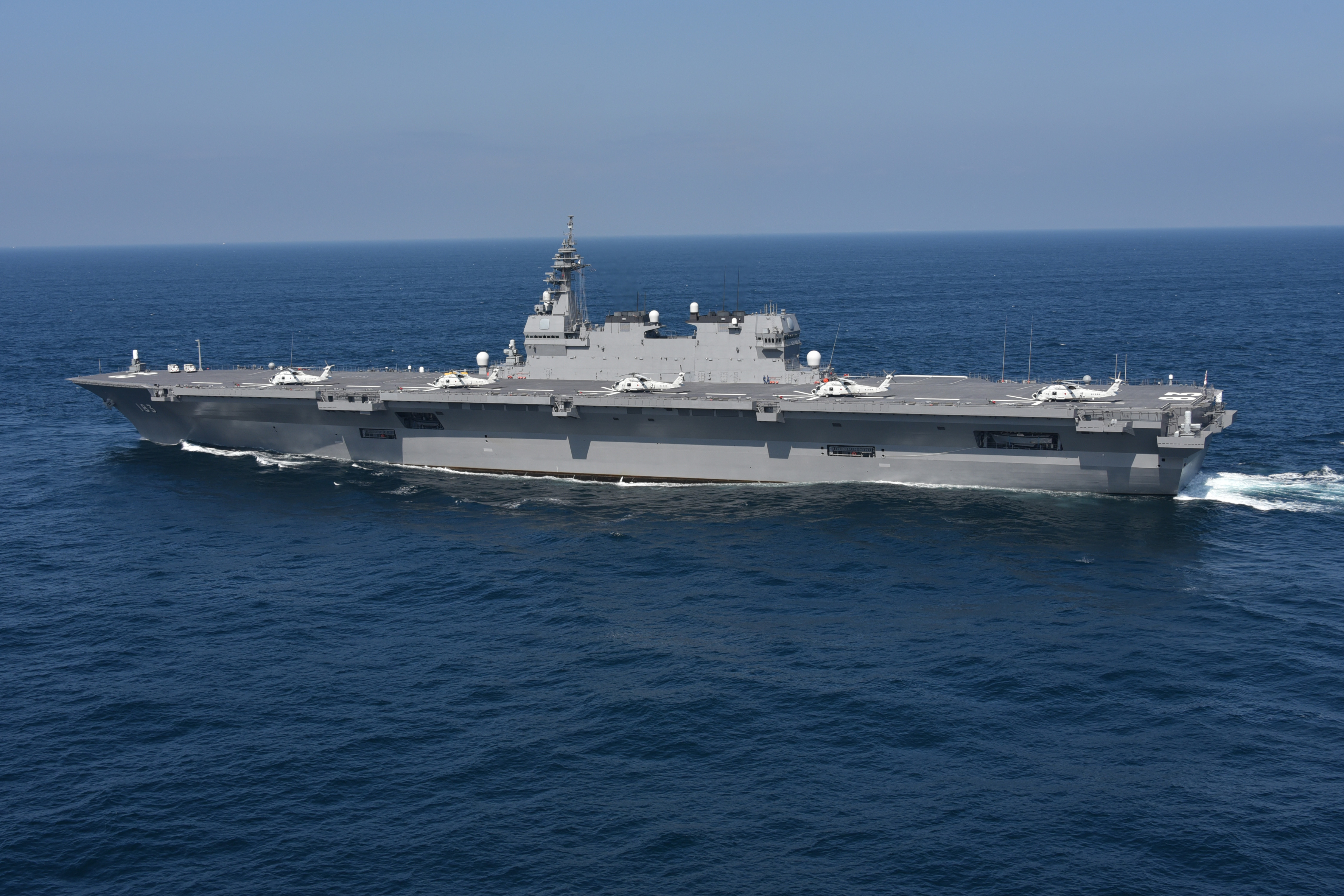This article originally featured in The Naval War College Review in 2008 and is republished with permission. Read it in its original form here. Read Part One of the republication here.
By Gabriel Collins, Andrew Erickson, Lyle Goldstein, and William Murray
Sensors, Systems, Research, Development, and Training
American efforts at exploiting advancements in commercial off-the-shelf technology have received attention. One article observes that “the updated (COTS) CCS MK II [fire control] system is not only used on the Los Angeles and Ohio classes, but is also used on the new Seawolf and Virginia class submarines”;44 another points out that “92% of the hardware and 90% of the software used in non-publicly available projects in fact come from popular commercially available technologies.”45 China’s intense interest in the U.S. Navy’s use of COTS may stem in part from Beijing’s effort to develop a world-class commercial information technology industry and to incorporate its products into the PLA.
Chinese analysts also monitor American submarine sensor development. One article notes, “At present, the U.S. is the world leader in developing periscope technology and using it on its submarines.”46 U.S. efforts to bolster the submarine force’s mine warfare capabilities receive particular attention.47 Moves to develop and acquire the Long Term Mine Reconnaissance System (LMRS) have been noted, with one researcher stating that “the U.S. is now buying 8 long-range mine scouting systems to be put on the Los Angeles and Virginia class nuclear attack submarines.”48
Chinese observers pay fairly close attention to American submarine-related research and development efforts. For example, websites on Chinese naval matters frequently report on the awarding of Defense Advanced Research Projects Agency (DARPA) and Office of Naval Research (ONR) contracts.49 Chinese journals take advantage of these announcements and also scour the U.S. open press for sources that can be exploited. For example, a rather lengthy article in the June 2002 issue of 现代舰船 (Modern Ships) reprinted the “Submarine of the Future” briefing slides (complete with a logo in the upper left-hand corner of each) generated by the DARPA-sponsored, Lockheed Martin–led industrial consortium “TEAM 2020.” These slides depict futuristic hull forms, sonar configurations, propulsors, weapons storage ideas, interfaces for unmanned underwater vehicles, and other elements of advanced submarine designs and concepts.50 It seems that little, if any, publicly released information regarding U.S. submarine-related research and development escapes the attention of Chinese analysts.
In keeping with the technological dynamism of U.S. platforms and their constant improvement, Chinese analysts also credit the American submarine force with an extremely rigorous selection and training process for commanding officers. In a coauthored article in Modern Navy, Rear Admiral Yang Yi, a PLA expert on the United States and former naval attaché in Washington, emphasizes that “the U.S. Navy’s selection process for the commanding officers of nuclear submarines is very strict.” Yang details the numerous education and training programs that successful candidates must attend, as well as the periodic qualifying tests they must undergo. A major emphasis of his article is the extent to which submarine commanders must periodically update their “specialized [technical] knowledge.”51
Historical Issues
Although China is emerging as a submarine power, its submarine force, and indeed its navy overall, generally lacks blue-water experience, to say nothing of a combat history. Of course, this paucity of experience stands in stark contrast to the U.S. submarine force, and PLA Navy analysts are acutely aware of that disparity. In fact, Chinese naval analysts have expressed particular admiration for the record of American submarines in World War II, pointing out that “the U.S. submarine force had the fewest losses” of any major submarine force “but had high combat effectiveness. According to statistics, the U.S. submarine force destroyed 1,314 enemy ships during the war.”52 Moreover, Chinese sources indicate an appreciation for the accumulated knowledge that the U.S. Navy has achieved through decades of intense submarine operations. Another Chinese source observes: “The U.S. is a country with 100 years of experience in building submarines, and with so many years of experience the USN constantly emphasizes the ability of a submarine to take punishment [and survive].”53
While there are numerous Chinese writings on the U.S. Navy’s submarine force’s campaign against Japan, this article focuses on the Chinese perceptions of American submarine operations during the Cold War. Some of the observations made in this context may explain aspects of contemporary PLA Navy submarine doctrine. For example, an article in Modern Ships relates an anecdote of a “Soviet Type 627 [known in the West as “November”] nuclear attack submarine [that] once went all out in a race with a U.S. Navy aircraft carrier, revealing the Soviet attack submarine’s capabilities. [This revelation] apparently has had a major impact on the development of a new class of American submarines.”54 This appraisal of the peacetime interaction between the two navies may suggest that overly aggressive tactics employed by the Soviet Navy yielded too much information to the U.S. Navy. In general, it is quite clear that Chinese sources understand that a “main mission of [U.S.] nuclear attack submarines [during the Cold War] was to deal with the Soviet Navy’s SSBNs.”55
With respect to the Cold War at sea, one Chinese book published in 2006 is worthy of particular note.56 The translation of a Russian book, Secrets of Cold War Undersea Espionage, states that “U.S. nuclear and conventional submarines would often lurk along the routes of Soviet warships, and even within Soviet territorial waters, conducting intelligence activities.”57 It is noted that “the SOSUS [Sound Surveillance] system substantially helped the U.S. to cope with the capabilities of the Soviet submarine force.”58 The subject of acoustic signatures is also raised: “In the ocean, there are simply too many sources of noise. . . . In order to cope with this problem, the U.S. decided to build an acoustic signature catalogue (resembling a fingerprint) for Soviet submarines.”59
Chinese ASW and the U.S. Navy Submarine Force
When considering Chinese views of the American submarine force, it is certainly relevant to consider how China appraises its own antisubmarine warfare forces. Generally, China considers its ASW forces to be weak. One Chinese naval analyst observes: “[Chinese] people are focused on China’s submarine force (both conventional and nuclear) development, but often neglect the threat we face from [U.S. Navy] submarines.”60 It is, moreover, suggested that “there is still a relatively large gap between [China’s] ASW technology level and that of the world’s advanced level.”61 In appraising the ASW capabilities of its own surface forces, another naval analyst notes, “Across the world, most naval ships are now equipped with towed array sonars, which has increased their ASW capabilities, but most of our ships only have hull mounted sonars.”62 Finally, there is a concern that these antisubmarine assets are themselves highly vulnerable: “Submarines can carry out ferocious missile attacks from tens or even 100–200km ranges, causing the submarine hunting vessels to become the hunted targets.”63
Chinese aerial ASW is also highlighted as a particular weakness. One Chinese analyst judges that the Z-9 helicopter lacks adequate range and internal space for the ASW mission.64 A second argues that while the Z-8 has better range and capacity, it is too big for most surface combatants to carry and chronic engine troubles have limited production.65 The Russian-import Ka-28 ASW helicopter is reported to be capable but few in numbers.66 As for Chinese maritime patrol aircraft, some designs have apparently been developed, including a variant of the Y-7 Fearless Albatross, but the outlook is said to remain bleak.67 Thus, one evaluation of Chinese aerial ASW concludes, “Our country at the present stage does not have an ASW maritime patrol aircraft . . . but the number of submarines in our peripheral seas is increasing, and their technological sophistication is also increasing. This contradiction is becoming more obvious every day, creating a grim situation.”68
In Chinese discussions of Russian ASW systems, there is a pointed recognition that the Soviets leaned heavily toward the use of tactical nuclear weapons (e.g., nuclear depth charges and torpedoes) in ASW operations.69 Tactical nuclear weapons are also mentioned in the context of mine warfare. An article in the July 2006 issue of Modern Navy, in discussing possible PLA Navy use of sea mines, suggests the potential combat value of nuclear-armed versions.70 It will be important to watch closely for any sign of Chinese efforts in this direction.
While the overall impression is that of Chinese ASW weakness, there is one notable exception. Significant prioritization appears to be given to the use of sea mines for the antisubmarine mission, as if to produce a “poor man’s ASW capability.”71 One discussion explains, “Because of a tremendous change in the maritime strategic environment, since the early 1990s the PLA has made mobile ASW sea mines a focal point of weapons development.” The analysis continues, “[China] is energetically undertaking the research mission [of] using [mobile ASW sea mines] against U.S. nuclear submarines.”72 The same discussion also hints at a review possible PLA Navy ASW role: “The major mission of self-guided sea mines is to isolate American nuclear submarines outside the First Island Chain.”73
It is noteworthy for the future development of Chinese antisubmarine warfare that hydroacoustics has been called a “key point” technology for state investment.74 The conventional wisdom has long been that the Chinese submarine force is focused entirely on the anti-surface ship mission. This assumption may have become outdated, perhaps especially after the PLA Navy received the last of eight new Kilo-class diesel submarines (and accompanying weaponry) from Russia in 2006. According to Professor Li Daguang of China National Defense University, these new Kilos have four missions: to blockade Taiwan, threaten carrier battle groups, employ land-attack cruise missiles as a “strategic weapon,” and “form an underwater threat to the U.S. nuclear submarine force.”75 There is also preliminary evidence that China is moving toward deploying antisubmarine rocket weapons on its newest surface combatants.76 This system is no “silver bullet,” as the Chinese would still have severe, perhaps insurmountable, targeting and cueing problems, but successful acquisition and deployment of ASROCs would extend the engagement range of Chinese ASW weapons significantly. It is also worth noting that Chinese sources discuss “many openly published dissertations concerning underwater targeting for a homing depth charge.”77
To reverse the equation: How do Chinese naval analysts appraise American ASW, and in particular the submarine force’s part in it? Clearly, the PLA Navy understands the overall centrality of SSNs in U.S. antisubmarine warfare. Thus an article in Modern Navy states: “The nuclear attack submarine . . . is the most effective tool for ASW.”78 However, some PLA Navy observers appear rather unimpressed by American efforts in ASW. The same official Chinese Navy journal observes: “The U.S. Navy actually has not had sufficient exercises in the [ASW arena] and also lacks experience.”79 In the same article, it is likewise noted that “conducting ASW in the littorals represents a special difficulty for the USN” and that “the combat advantage of the U.S. Navy nuclear submarine force in the littoral areas is far from obvious.”80 On this note, Campaign Theory Study Guide, a 2002 textbook written by China National Defense University scholars that draws on a variety of high-quality doctrinal publications, emphasizes that “nuclear powered attack submarines have difficulty operating in close proximity to shore due to natural conditions.”81 Another Chinese naval analysis suggests that “up to 2005, the USN has altogether 350 ASW platforms, just 11% of the number of [ASW] platforms it fielded in 1945. Moreover, many of these current naval and air platforms are not specialized for ASW, but more often are multi-mission platforms.”82 This quantitative comparison across historical periods is crude in some ways, but there is no denying that inherent physical principles combined with the vast geographical area of the Pacific Ocean will likely keep ASW an asset-intensive mission, even in the age of “net-centric warfare.”
The U.S. Navy Submarine Force-Level Trajectory
Chinese discussions of the American submarine force focus heavily on the continuing decline in its size. As one article from a People’s Republic of China (PRC) naval interest publication states, “The decline of U.S. submarine strength is inevitable.”83 Indeed, that a wide variety of Chinese naval sources share this evaluation suggests that this “decline” now passes for conventional wisdom within the PLA Navy. The Chinese naval community is likely paying close attention to internal U.S. debates, knowing that investments made (or forgone) today in submarine fleet modernization shape the future fleet.
Some Chinese assessments of the Seawolf program appear to point out indirectly the internal political tensions that hold down American submarine build rates now and perhaps in the future. One volume notes: “Although the Sea Wolf– class SSN gathers the era’s most advanced technology in a single hull, and possesses beyond-first-class performance, the appraisals of ‘Sea Wolf’ by American public figures from all walks of life differ, with a roughly half-and-half split between praise and condemnation.”84
Taking the long view, Chinese naval strategists recognize that force levels have dropped drastically from Cold War levels. One source observes, “Since 1989, the U.S. Navy’s nuclear-powered attack submarine [force] has been reduced by half.”85 A more recent Chinese naval press article estimates that “[U.S.] nuclear attack submarines will decline in number by close to 40%, eventually reaching 30 boats.”86 This calculation is roughly consistent with a projection in Modern Navy that anticipated a sustained build rate of one boat per year.87 Rear Admiral Yang Yi, writing in 2006 on the future size of the American submarine force, quoted one American analysis as follows: “China already exceeds [U.S. submarine production] five times over. . . . 18 [USN] submarines against 75 or more Chinese navy submarines is obviously not encouraging [from the U.S. perspective].”88
A Reputation for Mastery?
This article demonstrates that Chinese strategists are keenly interested in the U.S. Navy’s submarine force. Thousands of articles have reviewed various aspects of American submarine capabilities, operations, and developmental trends. There is clear evidence that Chinese naval analysts have enormous respect for U.S. submarines, submariners, and their weapons. Certainly, China aspires to be a submarine power and hopes to emulate certain aspects of American experience. However, it is equally clear in these writings that the U.S. submarine force is seen as a key challenge in any military confrontation between Beijing and Washington. It is significant in that regard especially that Chinese analysts are increasingly drawing attention to, and seeking to remedy, their antisubmarine warfare deficiencies. The study also reveals an apparent assumption within Chinese naval analytic circles that American submarine force levels are on a downward trajectory.
The authors are research faculty in the Center for Naval Warfare Studies at the Naval War College in Newport, Rhode Island. They are members (Dr. Goldstein is the founding director) of the College’s China Maritime Studies Institute. The opinions expressed in this report are those of the authors alone and not the assessments of the U.S. Navy or any other entity of the U.S. government.
References
- “美国雷声公司拟用商用流行技术更新潜 艇作战系统” [U.S. Raytheon Corporation Draws Up a Plan to Use COTS to Upgrade Subs’ Systems], 情报指挥控制系统与仿真 技术 [Intelligence, Command, Control, and Simulation Technology], no. 10 (2003), p. 19.
- 戴维 [Dai Wei], “ESM 对潜艇支持的新 作用” [ESM’s New Role in Submarine Support], 情报指挥控制系统与仿真技 术 [Intelligence, Command, Control, and Simulation Technology], no. 7 (1999), p. 19. 46. 李平, 陆炳哲 [Li Ping, Lu Bingzhe], “美 国虚拟潜望镜研究及进展” [Research and Progress of the American Virtual Periscope], 船舶电子工程 [Ship Electronic Engineering] 26, no. 5 (2006), p. 199.
- This article does not analyze Chinese examinations of U.S. sonar, navigation, combat control, ESM, or radio systems.
- 李书甫 [Li Shufu], “水下无人航行器” [UUVs], 舰载武器 [Shipborne Weapons], (April 2003), pp. 57–60.
- See, for example, the “US Submarines, Antisubmarine Warfare and All News” section of the China Defense.com Forum at www .china-defense.com/forum/index.php ?showtopic=1541.
- 王绪智 [Wang Xuzhi], “潜艇大革命—近岸 作战催生美国下—代多用途核潜艇” [The Submarine Revolution: Littoral Warfare Will Drive the Multirole Nature of America’s Next Generation Nuclear Submarine], 现代舰 船 [Modern Ships] (June 2002), pp. 30–33.
- 杨毅, 赵志军 [Yang Yi and Zhao Zhijun], “美国核潜艇艇长是怎样选拔的?” 17 Collins et al.: 85 [How Are American Submarine Commanding Officers Selected?], 当代海军 [Modern Navy] (December 2001), p. 17.
- 杜朝平 [Du Zhaoping], “美国为什么不装 备常规潜艇” [Why the U.S. Is Not Equipped with Conventional Submarines], 舰载武器 [Shipborne Weapons] (January 2004), p. 19.
- Qi Yaojiu, “Reflecting Again on the San Francisco,” p. 41.
- Ibid.
- Du Zhaoping, “Why the U.S. Is Not Equipped with Conventional Submarines,” p. 21.
- 拜科夫, 济科夫 [Zykov and Baikov—in Russian], 水下间谍战的秘密 [Secrets of Undersea Espionage] (Shanghai: Shanghai Translation, 2006).
- Ibid., p. 10.
- Ibid., p. 12.
- Ibid.
- Tai Feng, “Does China Need Antisubmarine Patrol Aircraft?” p. 70.
- 管带 [Guan Dai], “走向未来的中国反潜作战” [Looking toward Future PLA Navy Antisubmarine Warfare], 舰载武器 [Shipborne Weapons] (August 2005), p. 33.
- 蓝杰斌 [Lan Jiebin], “中国反潜装备的发展” [China’s ASW Equipment Development], 舰载武器[Shipborne Weapons] (February 2004), p. 29.
- 巡抚 [Xun Fu], “中国海军反潜武器的发展” [PLA Navy Antisubmarine Weapons Development], 舰载武器 [Shipborne Weapons] (August 2005), p. 29.
- Tai Feng, “Does China Need Antisubmarine Patrol Aircraft?” p. 73.
- Xun Fu, “PLA Navy Antisubmarine Weapons Development,” p. 30.
- Tai Feng, “Does China Need Antisubmarine Patrol Aircraft?” p. 73.
- Ibid., p. 75.
- Ibid., p. 73.
- See, for example, ibid., p. 72; and Xun Fu, “PLA Navy Antisubmarine Weapons Development,” p. 30.
- 刘衍中, 李祥 [Liu Yanzhong and Li Xiang], “实施智能攻击的现代水雷” [Carrying Out Intelligent Attacks with Modern Mines], 当 代海军 [Modern Navy] (July 2006), p. 29.
- For a much more detailed discussion of this issue, see Andrew Erickson, Lyle Goldstein, and William Murray, “China’s Undersea Sentries: Sea Mines Constitute Lead Element of PLA Navy’s ASW,” Undersea Warfare (Winter 2007), pp. 10–15.
- Lin Changcheng, “The Hidden Dragon in the Deep,” p. 30.
- Ibid., p. 31. The “first island chain” comprises Japan, its northern and southern archipelagoes, South Korea, Taiwan, the Philippines, and the Greater Sunda Islands. See Xu Qi, “Maritime Geostrategy and the Development of the Chinese Navy in the Early Twenty-first Century,” trans. Andrew S. Erickson and Lyle J. Goldstein, Naval War College Review 59, no. 4 (Autumn 2006), pp. 47–67, esp. note 11.
- Xun Fu, “PLA Navy Antisubmarine Weapons Development,” p. 28.
- 陈位吴 [Chen Weiwu], “解放军新基洛” [The PLA’s New Kilos], 国际展望 [World Outlook] (July 2006), p. 25.
- Xun Fu, “PLA Navy Antisubmarine Weapons Development,” p. 29.
- Ibid., p. 32.
- 许世勇 [Xu Shiyong], “美海军实施网络反潜 新战略” [The U.S. Navy’s New Network ASW Strategy], 当代海军 [Modern Navy] (September 2006), p. 44.
- Ibid. For an equally unimpressed American view, see John R. Benedict, “The Unraveling and Revitalization of U.S. Navy Antisubmarine Warfare,” Naval War College Review 58, no. 2 (Spring 2005), pp. 93–120.
- Xu Shiyong, “The U.S. Navy’s New Network ASW Strategy,” p. 44.
- 薛兴林 [Bi Xinglin, ed.], 战役理论学习指南 [Campaign Theory Study Guide] (国防大 学出版社 [National Defense University Press], 2002), vol. 3, p. 261.
- 石江月[Shi Jiangyue], “‘中国潜艇威胁’与美 军反潜战的复兴” [“The Chinese Submarine Threat” and the Revival of the U.S. Military’s ASW], 现代舰船 [Modern Ships] (May 2007), p. 17.
- 胡锦洋 [Hu Jinyang], “外媒: 中国海上‘狼 群’挑战美军潜艇霸权” [Foreign Media: China’s “Wolf Pack” at Sea Challenges American Submarine Hegemony], 海事大 观 [Maritime Spectacle] (July 2006), p. 45.
- Wang Yu and Yao Yao, eds., World Naval Submarines, p. 127.
- 孟昭珍, 张宁 [Meng Zhaozhen and Zhan Ning], “潜艇承担的新任务” [Submarines Assuming New Missions], 情报指挥控制系统 与仿真技术 [Intelligence, Command, Control, and Simulation Technology] (April 2003), p. 12.
- 石江月[Shi Jiangyue], “美国海军需要什么样 的舰队?” [What Kind of Fleet Does the U.S. Navy Require?], Navy Require?], 现代舰船 [Modern Ships], (December 2006), p. 12. 87. 张晓东, 王磊 [Zhang Xiaodong and Wang Lei], “美国海军未来 20 年发展规划” [The 20-Year Development Program of the U.S. Navy], 当代海军 [Modern Navy] (August 2006), p. 51. 88. Yang Yi, “Who Can Estimate the Future Number of Submarines?” p. 28.
Featured Image: Virginia-class submarine Indiana (SSN-789) Departs for Sea Trials, May 2018. (via Navsource)


